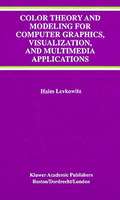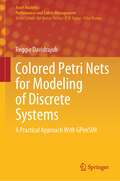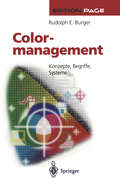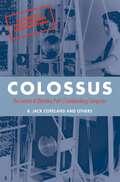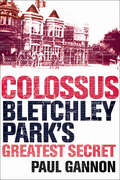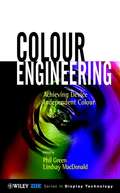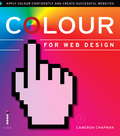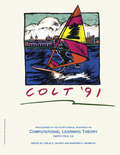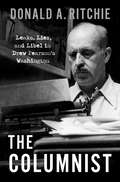- Table View
- List View
Color Theory and Modeling for Computer Graphics, Visualization, and Multimedia Applications (The Springer International Series in Engineering and Computer Science #402)
by Haim LevkowitzColor Theory and Modeling for Computer Graphics, Visualization, and Multimedia Applications deals with color vision and visual computing. This book provides an overview of the human visual system with an emphasis on color vision and perception. The book then goes on to discuss how human color vision and perception are applied in several applications using computer-generated displays, such as computer graphics and information and data visualization. Color Theory and Modeling for Computer Graphics, Visualization, and Multimedia Applications is suitable as a secondary text for a graduate-level course on computer graphics, computer imaging, or multimedia computing and as a reference for researchers and practitioners developing computer graphics and multimedia applications.
Colored Petri Nets for Modeling of Discrete Systems: A Practical Approach With GPenSIM (Asset Analytics)
by Reggie DavidrajuhThis book offers a practical approach to modeling real-world discrete systems and performing analysis. The theory behind the book is the Colored Petri nets, and the tool used for simulations is general-purpose Petri net simulator (GPenSIM). The theory part is kept to a minimum, and more explanation is given to the GPenSIM functions and how they can be used for modeling, simulation, and performance analysis. Real-world industrial systems possess a large number of resources. Modeling these systems with Petri nets would become a problem as they result in huge Petri net models. This book offers a unique solution to this problem by moving resources away from the Petri net model and treating them as variables in the background. Also, the theory and practice put forward in the book help cost estimation of the systems (e.g., manufacturing subsystems).
Colossus: The secrets of Bletchley Park's code-breaking computers
by B. Jack CopelandAt last - the secrets of Bletchley Park's powerful codebreaking computers. This is a history of Colossus, the world's first fully-functioning electronic digital computer. Colossus was used during the Second World War at the Government Code and Cypher School at Bletchley Park, where it played an invaluable role cracking enemy codes. Until very recently, much about the Colossus machine was shrouded in secrecy, largely because the codes that were employed remained in use by the British security services until a short time ago. This book only became possible due to the declassification in the US of wartime documents. With an introductory essay on cryptography and the history of code-breaking by Simon Singh, this book reveals the workings of Colossus and the extraordinary staff at Bletchley Park through personal accounts by those who lived and worked with the computer. Among them is the testimony of Thomas Flowers, who was the architect of Colossus and whose personal account, written shortly before he died, is published here for the first time. Other essays consider the historical importance of this remarkable machine, and its impact on the generations of computing technology that followed.
Colossus: Bletchley Park's Greatest Secret
by Paul GannonThis is the last untold story of Bletchley Park. Using declassified information, Paul Gannon gives us a gripping account of the invention of the world's first true computer, Colossus.Uncover the secrets of Bletchley Park's code-breaking computers.In 1940, almost a year after the outbreak of the Second World war, Allied radio operators at an interception station in South London began picking up messages in a strange new code. Using science, maths, innovation and improvisation Bletchley Park codebreakers worked furiously to invent a machine to decipher what turned out to be the secrets of Nazi high command. It was called Colossus.What these codebreakers didn't realize was that they had to fashion the world's first true computer. When the war ended, this incredible invention was dismantled and hidden away for almost 50 years. Paul Gannon has pieced together the tremendous story of what is now recognized as the greatest secret of Bletchley Park.'Gannon's book contains a mass of utterly fascinating and largely unknown material about an immensely important wartime project, and is very welcome indeed.' - Brian Rendell, TES
Colour Engineering: Achieving Device Independent Colour (Wiley Series in Display Technology #30)
by Phil Green Lindsay MacDonaldAs colour imaging takes on increasing importance in a range of products and technologies, colour fidelity across different media has become essential.This book has arisen from the need for a specialist text that brings together key developments in colour management technology and findings from the colour engineering research community.Edited by highly regarded specialists in colour management systems, Colour Engineering introduces the reader systematically to the art of constistent quality of image reproduction - regardless of the monitor or graphic user interface employed.Features: a thorough review of the elements of colour science that apply to colour imaging. a comprehensive analysis of methods for characterizing devices in the colour imaging chain. a review of the key topics in colour management. the different approaches to implementing colour systems at some of the leading exponents in the imaging industry. This authoritative book depicting the latest developments in colour imaging, written by a group of authors at the forefront of research in this exciting and fast-moving field will appeal to students as well as practitioners of the new discipline of colour engineering. The Society for Information Display (SID) is an international society, which has the aim of encouraging the development of all aspects of the field of information display. Complementary to the aims of the society, the Wiley-SID series is intended to explain the latest developments in information display technology at a professional level. The broad scope of the series addresses all facets of information displays from technical aspects through systems and prototypes to standards and ergonomics
Colour for Web Design: Apply Colour Confidently and Create Successful Websites
by Cameron ChapmanColour is one of the most powerful tools at a designer's disposal, yet few truly understand how much it can do for them, and the immediate difference it will make to the popularity and success of their website.This is the complete guide to creating a unique, practical and appropriate colour palette for any web design project. Building on the basics, starting with essential - often misunderstood - terminology and an understanding of traditional colour palettes, the book then moves on to practical, real-world examples of sites with fantastic colour schemes.A one-stop shop for a complete knowledge of digital colour, this book will give the designer the confidence to create their own palettes and apply colour successfully to their designs.
The Colour Image Processing Handbook
by Stephen J. Sangwine Robin E. N. HorneThis book is aimed at those using colour image processing or researching new applications or techniques of colour image processing. It has been clear for some time that there is a need for a text dedicated to colour. We foresee a great increase in the use of colour over the coming years, both in research and in industrial and commercial applications. We are sure this book will prove a useful reference text on the subject for practicing engineers and scientists, for researchers, and for students at doctoral and, perhaps masters, level. It is not intended as an introductory text on image processing, rather it assumes that the reader is already familiar with basic image processing concepts such as image representation in digital form, linear and non-linear filtering, trans forms, edge detection and segmentation, and so on, and has some experience with using, at the least, monochrome equipment. There are many books cov ering these topics and some of them are referenced in the text, where appro priate. The book covers a restricted, but nevertheless, a very important, subset of image processing concerned with natural colour (that is colour as per ceived by the human visual system). This is an important field because it shares much technology and basic theory with colour television and video equipment, the market for which is worldwide and very large; and with the growing field of multimedia, including the use of colour images on the Inter net.
The Colour Photography Field Guide: The Essential Guide to Hue for Striking Digital Images (Field Guide)
by Michael FreemanUnderstand the role colour plays in your images, learn to appreciate its dynamic effects and find out how to capture and reproduce it as precisely as possible in your own images.The Colour Photography Field Guide provides a unique look at analysing and combining three important ways of dealing with colour. The first is the subjective and cultural response to individual colour: the perception. The second is how colours are found and appear in photography: the science. The third is the means by which they can be viewed and altered digitally: the expression.- A clear and technically precise look at how colour affects your digital images- Portable and lightweight, for on-the-spot information and inspiration- With a host of case studies examining difficult colour situations such as capturing flesh tones and unreal colours
Coloured Petri Nets: Basic Concepts, Analysis Methods and Practical Use, Volume 1 (Monographs in Theoretical Computer Science. An EATCS Series)
by Kurt JensenThis book presents a coherent description of the theoretical and practical aspects of Coloured Petri Nets (CP-nets or CPN). It shows how CP-nets have been de veloped - from being a promising theoretical model to being a full-fledged lan guage for the design, specification, simulation, validation and implementation of large software systems (and other systems in which human beings and/or com puters communicate by means of some more or less formal rules). The book contains the formal definition of CP-nets and the mathematical theory behind their analysis methods. However, it has been the intention to write the book in such a way that it also becomes attractive to readers who are more interested in applications than the underlying mathematics. This means that a large part of the book is written in a style which is closer to an engineering textbook (or a users' manual) than it is to a typical textbook in theoretical computer science. The book consists of three separate volumes. The first volume defines the net model (i. e. , hierarchical CP-nets) and the basic concepts (e. g. , the different behavioural properties such as deadlocks, fair ness and home markings). It gives a detailed presentation of many smaIl exam ples and a brief overview of some industrial applications. It introduces the for mal analysis methods. FinaIly, it contains a description of a set of CPN tools which support the practical use of CP-nets.
Coloured Petri Nets: Basic Concepts, Analysis Methods and Practical Use. Volume 1 (Monographs in Theoretical Computer Science. An EATCS Series)
by Kurt JensenThis book presents a coherent description of the theoretical and practical aspects of Coloured Petri Nets (CP-nets or CPN). It shows how CP-nets have been de veloped - from being a promising theoretical model to being a full-fledged lan guage for the design, specification, simulation, validation and implementation of large software systems (and other systems in which human beings and/or com puters communicate by means of some more or less formal rules). The book contains the formal definition of CP-nets and the mathematical theory behind their analysis methods. However, it has been the intention to write the book in such a way that it also becomes attractive to readers who are more interested in applications than the underlying mathematics. This means that a large part of the book is written in a style which is closer to an engineering textbook (or a users' manual) than it is to a typical textbook in theoretical computer science. The book consists of three separate volumes. The first volume defines the net model (i. e. , hierarchical CP-nets) and the basic concepts (e. g. , the different behavioural properties such as deadlocks, fair ness and home markings). It gives a detailed presentation of many small exam ples and a brief overview of some industrial applications. It introduces the for mal analysis methods. Finally, it contains a description of a set of CPN tools which support the practical use of CP-nets.
Coloured Petri Nets: Basic Concepts, Analysis Methods and Practical Use (Monographs in Theoretical Computer Science. An EATCS Series)
by Kurt JensenThe contents of this volume are application oriented. The volume contains a de tailed presentation of 19 applications of CP-nets, covering a broad range of ap plication areas. Most of the projects have been carried out in an industrial set ting. The volume presents the most important ideas and experiences from the projects, in a way which is useful also for readers who do not yet have personal experience with the construction and analysis of large CPN models. The volume demonstrates the feasibility of using CP-nets and the CPN tools for industrial projects. The presentation of the projects is based upon material provided by the per sons who have accomplished the individual projects. At the beginning of each chapter, we list their names and we say where the original material has been published. The original material often contains more elaborate information, e.g., about details of the modelled system and related work. I have edited the material provided by the original authors. I have modified some of the CP-nets, e.g., to improve the layout and use more mnemonic names. In some cases, I have also changed a few net components, e.g., merged two tran sitions or introduced a Standard ML function for operations that are used in many arc expressions. These modifications make the CP-nets more appropriate as study material, but they do not change the essential behaviour of the CPN models.
Coloured Petri Nets: Modelling and Validation of Concurrent Systems
by Kurt Jensen Lars M. KristensenColoured Petri Nets (CPN) is a graphical language for modelling and validating concurrent and distributed systems, and other systems in which concurrency plays a major role. The development of such systems is particularly challenging because of inherent intricacies like possible nondeterminism and the immense number of possible execution sequences. In this textbook Jensen and Kristensen introduce the constructs of the CPN modelling language and present the related analysis methods in detail. They also provide a comprehensive road map for the practical use of CPN by showcasing selected industrial case studies that illustrate the practical use of CPN modelling and validation for design, specification, simulation, verification and implementation in various application domains. Their presentation primarily aims at readers interested in the practical use of CPN. Thus all concepts and constructs are first informally introduced through examples and then followed by formal definitions (which may be skipped). The book is ideally suitable for a one-semester course at an advanced undergraduate or graduate level, and through its strong application examples can also serve for self-study. An accompanying website offers additional material such as slides, exercises and project proposals. Book website: http://www.cs.au.dk/CPnets/cpnbook/
COLT '89: Proceedings of the Second Annual Workshop, UC Santa Cruz, California, July 31 - August 2 1989
by ColtComputational Learning Theory presents the theoretical issues in machine learning and computational models of learning. This book covers a wide range of problems in concept learning, inductive inference, and pattern recognition. Organized into three parts encompassing 32 chapters, this book begins with an overview of the inductive principle based on weak convergence of probability measures. This text then examines the framework for constructing learning algorithms. Other chapters consider the formal theory of learning, which is learning in the sense of improving computational efficiency as opposed to concept learning. This book discusses as well the informed parsimonious (IP) inference that generalizes the compatibility and weighted parsimony techniques, which are most commonly applied in biology. The final chapter deals with the construction of prediction algorithms in a situation in which a learner faces a sequence of trials, with a prediction to be given in each and the goal of the learner is to make some mistakes. This book is a valuable resource for students and teachers.
COLT '91: Proceedings of the Fourth Annual Workshop, UC Santa Cruz, California, August 5-7, 1991
by ColtCOLT
COLT Proceedings 1990
by ColtCOLT '90 covers the proceedings of the Third Annual Workshop on Computational Learning Theory, sponsored by the ACM SIGACT/SIGART, University of Rochester, Rochester, New York on August 6-8, 1990. The book focuses on the processes, methodologies, principles, and approaches involved in computational learning theory. The selection first elaborates on inductive inference of minimal programs, learning switch configurations, computational complexity of approximating distributions by probabilistic automata, and a learning criterion for stochastic rules. The text then takes a look at inductive identification of pattern languages with restricted substitutions, learning ring-sum-expansions, sample complexity of PAC-learning using random and chosen examples, and some problems of learning with an Oracle. The book examines a mechanical method of successful scientific inquiry, boosting a weak learning algorithm by majority, and learning by distances. Discussions focus on the relation to PAC learnability, majority-vote game, boosting a weak learner by majority vote, and a paradigm of scientific inquiry. The selection is a dependable source of data for researchers interested in the computational learning theory.
Column Layout Examples (large print)
by RnibThis diagram shows examples of three of the many column layouts that might be used in a print publication. There is a locator dot shown, which will be at the top left of the page when the image is the right way up. There are descriptive labels on the left of the page and layout examples on the right. In each example, the horizontal lines texture indicates areas of body text, and the fine dotted textured areas represent columns that might be used for headings, annotations, a table of contents, pull quotes, images, advertisements or even left empty to give the page an uncluttered look. Each example shows a single page.
Column Layout Examples (UEB contracted)
by RnibThis diagram shows examples of three of the many column layouts that might be used in a print publication. There is a locator dot shown, which will be at the top left of the page when the image is the right way up. There are descriptive labels on the left of the page and layout examples on the right. In each example, the horizontal lines texture indicates areas of body text, and the fine dotted textured areas represent columns that might be used for headings, annotations, a table of contents, pull quotes, images, advertisements or even left empty to give the page an uncluttered look. Each example shows a single page.
Column Layout Examples (UEB uncontracted)
by RnibThis diagram shows examples of three of the many column layouts that might be used in a print publication. There is a locator dot shown, which will be at the top left of the page when the image is the right way up. There are descriptive labels on the left of the page and layout examples on the right. In each example, the horizontal lines texture indicates areas of body text, and the fine dotted textured areas represent columns that might be used for headings, annotations, a table of contents, pull quotes, images, advertisements or even left empty to give the page an uncluttered look. Each example shows a single page.
The Columnist: Leaks, Lies, and Libel in Drew Pearson's Washington
by Donald A. RitchieLong before Wikileaks and social media, the journalist Drew Pearson exposed to public view information that public officials tried to keep hidden. A self-professed "keyhole peeper", Pearson devoted himself to revealing what politicians were doing behind closed doors. From 1932 to 1969, his daily "Washington Merry-Go-Round" column and weekly radio and TV commentary broke secrets, revealed classified information, and passed along rumors based on sources high and low in the federal government, while intelligence agents searched fruitlessly for his sources. For forty years, this syndicated columnist and radio and television commentator called public officials to account and forced them to confront the facts. Pearson's daily column, published in more than 600 newspapers, and his weekly radio and television commentaries led to the censure of two US senators, sent four members of the House to prison, and undermined numerous political careers. Every president from Franklin Roosevelt to Richard Nixon--and a quorum of Congress--called him a liar. Pearson was sued for libel more than any other journalist, in the end winning all but one of the cases. Breaking secrets was the heartbeat of Pearson's column. His ability to reveal classified information, even during wartime, motivated foreign and domestic intelligence agents to pursue him. He played cat and mouse with the investigators who shadowed him, tapped his phone, read his mail, and planted agents among his friends. Yet they rarely learned his sources. The FBI found it so fruitless to track down leaks to the columnist that it advised agencies to simply do a better job of keeping their files secret. Drawing on Pearson's extensive correspondence, diaries, and oral histories, The Columnist reveals the mystery behind Pearson's leaks and the accuracy of his most controversial revelations.
The Columnist: Leaks, Lies, and Libel in Drew Pearson's Washington
by Donald A. RitchieLong before Wikileaks and social media, the journalist Drew Pearson exposed to public view information that public officials tried to keep hidden. A self-professed "keyhole peeper", Pearson devoted himself to revealing what politicians were doing behind closed doors. From 1932 to 1969, his daily "Washington Merry-Go-Round" column and weekly radio and TV commentary broke secrets, revealed classified information, and passed along rumors based on sources high and low in the federal government, while intelligence agents searched fruitlessly for his sources. For forty years, this syndicated columnist and radio and television commentator called public officials to account and forced them to confront the facts. Pearson's daily column, published in more than 600 newspapers, and his weekly radio and television commentaries led to the censure of two US senators, sent four members of the House to prison, and undermined numerous political careers. Every president from Franklin Roosevelt to Richard Nixon--and a quorum of Congress--called him a liar. Pearson was sued for libel more than any other journalist, in the end winning all but one of the cases. Breaking secrets was the heartbeat of Pearson's column. His ability to reveal classified information, even during wartime, motivated foreign and domestic intelligence agents to pursue him. He played cat and mouse with the investigators who shadowed him, tapped his phone, read his mail, and planted agents among his friends. Yet they rarely learned his sources. The FBI found it so fruitless to track down leaks to the columnist that it advised agencies to simply do a better job of keeping their files secret. Drawing on Pearson's extensive correspondence, diaries, and oral histories, The Columnist reveals the mystery behind Pearson's leaks and the accuracy of his most controversial revelations.
COM and .NET Interoperability
by Andrew TroelsenAuthor Andrew Troelsen tells about the building blocks of the COM and .NET architectures and how they interact (i.e. interoperate), with emphasis on a basic understanding of each component part and the role it plays.
Combat Modeling (International Series in Operations Research & Management Science #134)
by Alan Washburn Moshe Kress"Combat Modeling" is a systematic learning resource and reference text for the quantitative analysis of combat. After a brief overview, authors Washburn and Kress present individual chapters on shooting without feedback; shooting with feedback; target defense; attrition models; game theory and wargames; search; unmanned aerial vehicles; and terror and insurgency. Three appendices provide a review of basic probability concepts, probability distributions, and Markov models; an introduction to optimization models; and a discussion of Monte-Carlo simulations. Drawing on their many years of experience at the Naval Postgraduate School in Monterey, California, Washburn and Kress have created a reference that will provide the tools and techniques for analysts involved in the underpinnings of combat decisions. This is a book that can be used as a military manual, reference book, and textbook for military courses on this vital subject.
Combating Fake News with Computational Intelligence Techniques (Studies in Computational Intelligence #1001)
by Mohamed Lahby Al-Sakib Khan Pathan Yassine Maleh Wael Mohamed Shaher YafoozThis book presents the latest cutting-edge research, theoretical methods, and novel applications in the field of computational intelligence techniques and methods for combating fake news. Fake news is everywhere. Despite the efforts of major social network players such as Facebook and Twitter to fight disinformation, miracle cures and conspiracy theories continue to rain down on the net. Artificial intelligence can be a bulwark against the diversity of fake news on the Internet and social networks. This book discusses new models, practical solutions, and technological advances related to detecting and analyzing fake news based on computational intelligence models and techniques, to help decision-makers, managers, professionals, and researchers design new paradigms considering the unique opportunities associated with computational intelligence techniques. Further, the book helps readers understand computational intelligence techniques combating fake news in a systematic and straightforward way.
Combating Human Trafficking: A Multidisciplinary Approach
by Michael J. PalmiottoA centuries-old crime, human trafficking occurs not only in undeveloped countries, but also in some surprising locations. Right here in the United States, individuals are recruited, transported, and held by unlawful means�either through deception or under threat of violence. Approaching the topic from a law enforcement perspective, Combating Human
